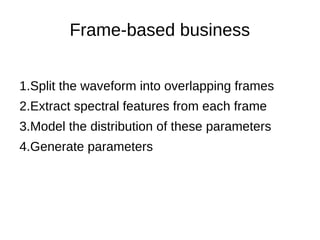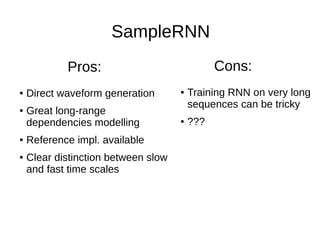DataScienceLab2017_Блиц-доклад
- 1. Sample based generative models for speech synthesis Дмитро Бєлєвцов @ IBDI
- 2. Frame-based business 1.Split the waveform into overlapping frames
- 3. Frame-based business 1.Split the waveform into overlapping frames 2.Extract spectral features from each frame
- 4. Frame-based business 1.Split the waveform into overlapping frames 2.Extract spectral features from each frame 3.Model the distribution of these parameters
- 5. Frame-based business 1.Split the waveform into overlapping frames 2.Extract spectral features from each frame 3.Model the distribution of these parameters 4.Generate parameters
- 6. Frame-based business 1.Split the waveform into overlapping frames 2.Extract spectral features from each frame 3.Model the distribution of these parameters 4.Generate parameters 5.Convert parameters back to the waveform
- 7. Frame-based business ● 100x lower time resolution ● Phase-invariant ● Naturally motivated ● Highly compressed ● Separated from pitch Pros:
- 8. Frame-based business ● 100x lower time resolution ● Phase-invariant ● Naturally motivated ● Highly compressed ● Separated from pitch Pros: ● Highly compressed ● Synthesis introduces unnaturalness Cons:
- 9. WaveNet
- 10. WaveNet ● Deep
- 12. WaveNet ● Deep ● Residual ● Convolutional
- 13. WaveNet ● Deep ● Residual ● Convolutional ● Sample-based
- 14. WaveNet ● Deep ● Residual ● Convolutional ● Sample-based ● Probabilistic
- 15. WaveNet ● Deep ● Residual ● Convolutional ● Sample-based ● Probabilistic ● Conditional
- 16. WaveNet ● Deep ● Residual ● Convolutional ● Sample-based ● Probabilistic ● Conditional ● Generative
- 17. WaveNet ● Deep ● Residual ● Convolutional ● Sample-based ● Probabilistic ● Conditional ● Generative ● Auto-regressive
- 18. WaveNet ● Deep ● Residual ● Convolutional ● Sample-based ● Probabilistic ● Conditional ● Generative ● Auto-regressive
- 19. How does it work? dilated causal convolutions
- 20. How does it work?
- 21. Trained like a CNN
- 22. Generates like an RNN (with limited memory)
- 23. So how is it? ● Direct waveform generation ● State-of-the-art timbre quality ● CNN-like training Pros:
- 24. So how is it? ● Direct waveform generation ● State-of-the-art timbre quality ● CNN-like training Pros: ● Slow generation (40x slower than realtime on commodity CPU) * ● Sensitive to local condition ● Large memory footprint ● Hard to interpret ● Missing details Cons:
- 26. SampleRNN
- 27. SampleRNN
- 28. SampleRNN
- 29. SampleRNN ● Direct waveform generation ● Great long-range dependencies modelling ● Reference impl. available ● Clear distinction between slow and fast time scales Pros: ● Training RNN on very long sequences can be tricky ● ??? Cons:
- 30. Papers to check out ● WaveNet: A Generative Model for Raw Audio (Oord et al. 2016) ● Fast Wavenet Generation Algorithm (Paine et al. 2016) ● Deep Voice: Real-time Neural Text-to-Speech (Arik et al. 2017) ● A Neural Parametric Singing Synthesizer (Blaauw et al. 2017) ● SamplerRNN: An Unconditional End-To-End Neural Audio Generation Model (Mehri et al. 2017) ● Char2wav: End-To-End Speech Synthesis (Sotelo et al. 2017)
- 31. Thanks!































